The American National Metric Council (ANMC) was a non-profit, tax-exempt planning and coordinating organization for metric activity in all sectors of the U.S. economy.
ANMC was established in 1973 by the American National Standards Institute (ANSI) and became a separately incorporated organization in 1976. ANMC was intended to facilitate America’s metric transition by maintaining a voluntary and orderly process that minimizes costs and maximizes benefits, and to provide information, forums, individual assistance, and other services for its subscribers.
As the first issue of ANMC’s Metric Reporter explained in 1973:
The problems of metric conversion will involve not a few; rather it will involve hundreds of large and small corporations, associations, and technical societies. The interests of government and labor groups must be brought to bear. International trade becomes a factor.
These complications point to one clear solution — a single coordinating body in the private sector to aid all the organized elements of U.S. society to reach common goals in metric conversion. In filling this role, ANMC will help insure the proper and consistent application of metric units and practices, thus preventing the costly proliferation of divergent practices.
Voluntary consensus is the key to ANMC coordination. Sector committees, made up of the people most directly affected, will study the impact of metric conversion on particular sectors of industry and commerce. These sector committees will be guided by coordinating committees, of which the chairman and vice-chairman will be members of the Executive Board of ANMC.
The following organization chart from an ANMC brochure shows its planned structure.
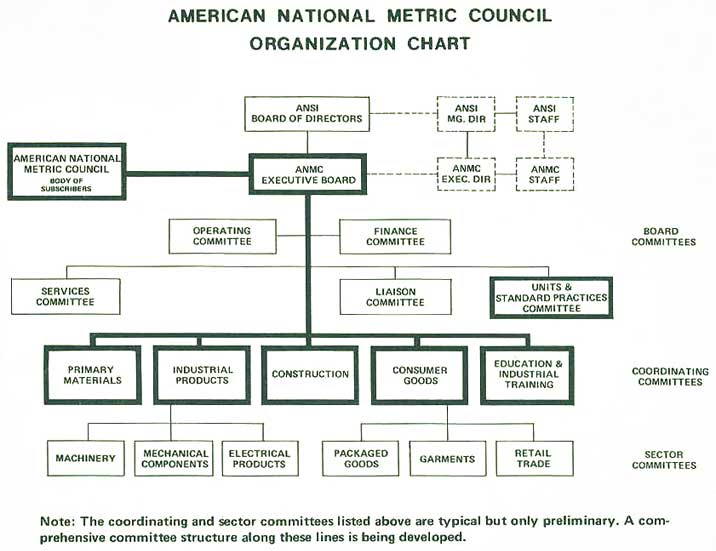
American National Metric Council history
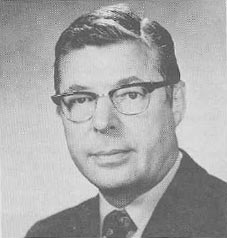
Adrian G. Weaver, ANMC’s first Chairman.
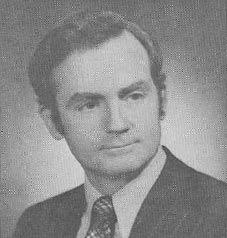
Dr. Malcolm E. O’Hagan, ANMC’s first Executive Director.
The President and management of ANSI decided to create the ANMC during the summer of 1972. That action was in response to the increasing interest in the use of the metric system by most sectors of the U.S. economy, by educators, and by both the legislative and administrative branches of the U.S. Government. The results of the U.S. Metric Study, carried out under the auspices of the U.S. Department of Commerce, had been available for about a year; several metric bills had been introduced in both houses of Congress; and the Senate subsequently passed metric legislation; but no action was taken by the House prior to adjournment of the 92nd Congress.
In his letter of 14 August 1972, ANSI President Roy P. Trowbridge invited executives of industry, labor, and national organizations with a stake in metrication to a meeting at The Engineers’ Club in New York on 7 September. The purpose of that meeting was to ascertain the feasibility of establishing a metric planning and coordinating activity in the private sector under ANSI auspices. A key passage from the President’s letter contains the fundamental policy of ANSI with regard to the Council:
“This action by ANSI is not intended to substitute for, or preclude the need for, legislative action on increased metric usage in the United States. . . . The Institute clearly recognizes that a massive, well-coordinated, soundly-planned, and properly-managed activity will be required in the private sector, with full government participation, if a move to increased metric usage is to occur so as to provide . . .beneficial effect . . . .”
At the meeting, the conferees unanimously agreed to recommend that ANSI proceed with planning, leading to the formation of the proposed Council; that a small Ad Hoc Planning Committee be appointed to further refine the proposed structure and funding; and that the results be reported back to the group in order that a final recommendation could be made to ANSI’s Board of Directors.
The Ad Hoc Planning Committee met at The Engineers’ Club in New York on 4 October 1972. The meeting drafted a report to the ANSI Board of Directors, after which the Board unanimously approved the report. Approval included endorsement in principle of the premises, purposes, and objectives of the proposed Council. The ANSI Board also approved the suggested initial funding for ANMC.
Subsequently, the Planning Committee met again at The Engineers’ Club in New York on 24 October 1972. The result of this meeting was a second report, dealing with the appointment of the Executive Committee, initial financing, and the policy guidelines of the Council. That second report was submitted for ratification by the ANSI Board of Directors. The Board thoroughly examined and discussed the Planning Committee’s report, and unanimously approved the report.
As a result of the Planning Committee’s recommendations and their approval by the ANSI Board of Directors, an Executive Committee of the ANMC was appointed, broadly representative of the interests of commerce, industry, labor, consumers, and government. With that appointment the ANMC became reality.
The Executive Committee was responsible for development of the ANMC, including its organizational structure, its initial composition, its program of work, its budget, and its long-range method of financing. Mr. Adrian G. Weaver, Director of Standards Practices of IBM, was appointed as the first Chairman of the Executive Committee of the ANMC and Dr. Malcom E. O’Hagan was appointed the Executive Director of ANMC.
Coordination with the USMB
ANMC saw the need to coordinate the metric planning activities of many industrial sectors, unlike the USMB, which was established primarily to implement the policy set forth by in the Metric Conversion Act of 1975. After the formation of the USMB, committees of ANMC submitted conversion plans for two sectors: chemical and instruments. Those sector conversion plans were later approved by the USMB.
ANMC Publications
Metric Conversion Papers
During the 1970s, ANMC produced a series of 16 Metric Conversion Papers, a collection of articles, speeches, and other material developed by experts in their fields. The Papers deal with specific management issues, developments in certain industries, the problems and opportunities of conversion, and company case studies.
In addition, ANMC staff and volunteers produced many other metric-related booklets, as well as special publications with appeal to specific industries, developed by committees sponsored by ANMC.
Metric Reporter

ANMC’s newsletter, Metric Reporter, was first published in September 1973. The newsletter provided editorials, feature stories, news, and updated information on the status and progress of metric activities within the U.S. government, foreign countries, private industries, and ANMC itself. The Metric Reporter, as a major source of such information on metric issues in the United States, was continuously published through 1999. All issues of the Metric Reporter have been scanned and are available in PDF from USMA.
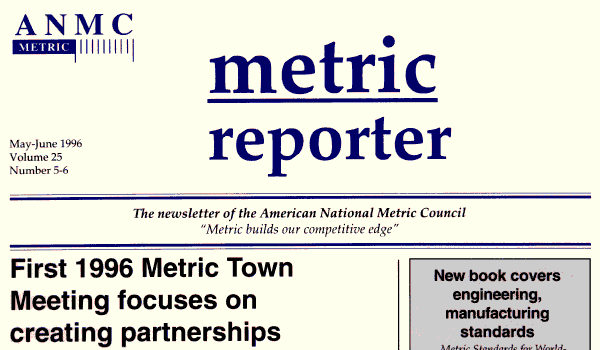
Metric Messenger for Consumers
ANMC also published Metric Messenger for Consumers, a newsletter intended for the general public.
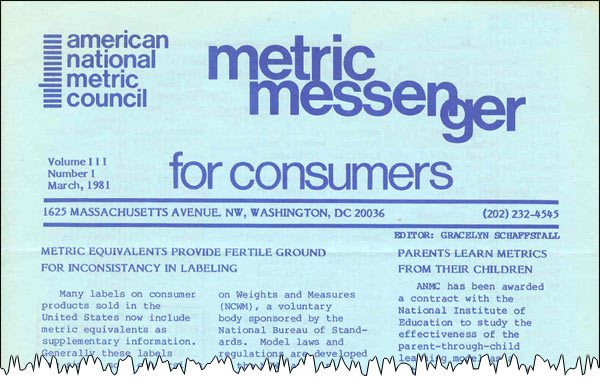
We have copies of only a few issues, but this newsletter appears to have been published quarterly from 1979 through (at least) 1981.
ANMC Conferences
From 1975 through 1987, ANMC held a series of well-attended annual conferences. Subsequently, a series of National Metric Conferences, jointly sponsored by the ANMC, U.S. Metric Association (USMA), the U.S. Department of Commerce, and the National Institute of Standards and Technology (NIST), were held from 1989 through 1993.
Back to USMA home.
Copyright © 2007–2010, US Metric Association (USMA), Inc. All rights reserved.
Updated: 2012-06-15